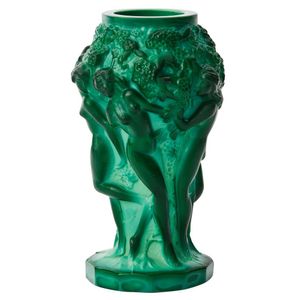Bohemian Malachite Glass Vase with Nude Frieze
An Art Deco Bohemian malachite glass vase, the tapered body moulded in relief with a continuous frieze depicting nudes harvesting grapes. Height 13 cm. Provenance: Barry Stern Galleries. Private collection, Sydney
You must be a subscriber, and be logged in to view price and dealer details.
Subscribe Now to view actual auction price for this item
When you subscribe, you have the option of setting the currency in which to display prices to $Au, $US, $NZ or Stg.
This item has been sold, and the description, image and price are for reference purposes only.
- Art Deco Period - The Art Deco period was a cultural movement that emerged in the 1920s and 1930s, and was characterized by its emphasis on modernism, luxury, and elegance. The name "Art Deco" comes from the Exposition Internationale des Arts Décoratifs et Industriels Modernes, a large exhibition held in Paris in 1925 that showcased the latest trends in decorative arts.
Art Deco was a reaction against the ornate and elaborate styles of the previous era, and reflected a new modern sensibility. It was characterized by streamlined, geometric shapes, bright colours, and the use of new materials such as chrome, glass, and Bakelite. Art Deco designers sought to create a sense of luxury and sophistication, often incorporating expensive materials such as ivory, marble, and rare woods.
Art Deco had a significant impact on a wide range of artistic fields, including architecture, fashion, graphic design, and interior design. Some of the most iconic examples of Art Deco architecture include the Empire State Building in New York City, the Hoover Building in London, and the Palais de Chaillot in Paris.
The Art Deco period came to an end in the 1940s, as World War II and changing cultural trends led to a shift in artistic styles. However, Art Deco remains an important influence on design and art, and continues to be celebrated for its modernist sensibility and glamorous aesthetic. - Malachite - Malachite is bright copper-green coloured stone with concentric layers which displays distinct contrasting veinings. It has been valued in the past for making or decorating small precious objects such as clocks, jewellery, dishes and so. In the Orient it was used for snuff bottles and in Russia and was favoured by the Faberge workshop. larger pieces were used for table tops.
The principal source of supply was Russia but it is to be found in other regions such as Southern Africa, Mexico, Australia and France.
Malachite glass is a manufactured material that was intended to resemble malachite, but often bears more resemblance to a veined coloured marble due to its lower gloss finish and lack of concentric layers. Malachite glass was manufactured by many glassworks in the 19th century including Loetz in Austria and others in Bohemia and Davidson's Greener's and Sowerby in north eastern England.
It was particularly used for scent bottles, bowls, and small vases often decorated with nymphs.
Malachite glass has been manufactured continuously since the late nineteenth century, most is unmarked and it is difficult to distinguish the age or manufacturer of most commercial pieces. - Frieze - An architectural term denoting the flat, shaped or convex horizontal surface of furniture, between the architrave and the cornice, usually found on a cabinet or bookcase, or on desks and tables where it may include drawers, the area between the top and the legs. In ceramics, the term refers to the banding, of usually a repeating pattern, on the rims of plates and vases.
This item has been included into following indexes:
-
Bohemian (Czech Republic) glass wares
- various wares 458
- vases 237
- malachite - glass decoration style 76
